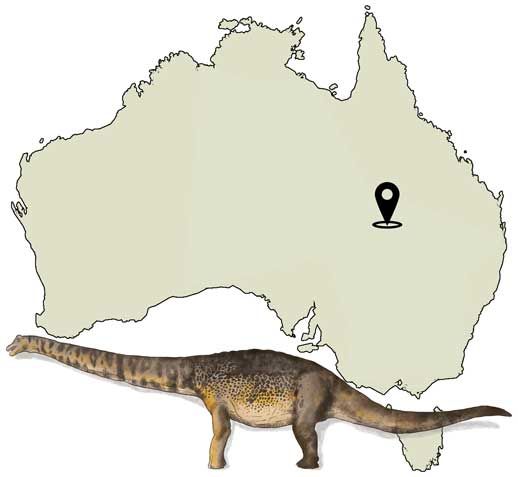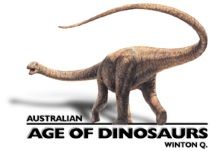Australotitan cooperensis
Pronunciation
Oss-trah-low-tie-tan coo-per-ennsiss
Meaning
Cooper’s (from Cooper-Eromanga Basin) southern (australo) giant (titan)
Period
Middle Cretaceous (100–95 Mya)
Discovery and publication
Found west of Eromanga in southeast Queensland in 2005 by Sandy Mackenzie, Australotitan was prepared and excavated by the Queensland Museum and the Eromanga Natural History Museum between 2005 and 2010. The holotype, nicknamed Cooper, was described by Dr Scott Hocknull and others in 2021, based on a partial skeleton consisting of a partial left scapula, partial left and complete right humerus, right ulna, the right and left pubis and ischia and partial right and left femora. An additional three specimens were referred to the genus. These include EMF164 (nicknamed George), consisting of a fragmented femur, a fragmented ulna, presacral vertebrae fragments and rib fragments, EMF105, consisting of a complete femur and EMF165, which consists of a distal humerus.
Description
Australotitan cooperensis represents the largest dinosaur in Australia and confirms the presence of gigantic titanosaurian sauropods in eastern Gondwana during the mid-Cretaceous Period.
Australotitan is believed to be 30 metres long and 6.5 metres high from the hip. Despite its size Australotitan is thought to be closely related to other Australian sauropods due to shared characteristics found in the ischium between Diamantinasaurus and Wintonotitan; shared pneumatic anterior caudal vertebrae in Savannasaurus and Wintonotitan; and ubiquitous presence of amphicoelous caudal vertebrae from described and undescribed specimen. Researchers have hypothesised that this common ancestry, between all four Australian sauropod taxa, indicates diversification during the mid-Cretaceous and supports the recent naming of an Australian clade: Diamantinasauria. Due to its size Australotitan probably lived in a lush environment filled with tall trees and small shrubs that could support such large animals. Interestingly while the fossils are massive they are also exceptionally narrow, possibly as a result of being trampled by other sauropods.
In research led by Samantha Beeston et al, as of 2024, Australotitan is no longer classified as a valid species of dinosaur. The former holotype (Cooper) has been identified as an indeterminate member of the clade Diamantinasauria, which includes Australian sauropods like Savannasaurus, Wintonotitan and Diamantinasaurus, as well as the South American sauropod Sarmientosaurus. This new research confirms the presence of gigantic titanosaurian sauropods in eastern Gondwana during the mid-Cretaceous Period.
